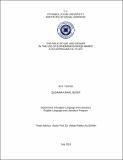DSpace Repository
THE ROLE OF AGE AND GENDER IN THE USE OF EUPHEMISM IN IRAQI ARABIC A SOCIOPRAGMATIC STUDY
JavaScript is disabled for your browser. Some features of this site may not work without it.
| dc.contributor.author | seger, qudama kamil
|
|
| dc.date.accessioned | 2021-04-15T06:48:17Z | |
| dc.date.available | 2021-04-15T06:48:17Z | |
| dc.date.issued | 2019 | |
| dc.identifier.uri | http://hdl.handle.net/11547/7136 | |
| dc.description.abstract | The role of euphemism comes to be a vital part of any language as a tool that people can use to refine their use of language and save their social relationships with each other. Many social factors influence the use of language, such as age, gender, social distance, level of education and region. The current study is an endeavor to investigate the role of age and gender in the use of euphemism in Iraqi Arabic. It was based partially on the study of Al-Azzeh (2010) and Ghounane (2013). A quantitative method was adopted with a questionnaire that consisted of 19 questions. The sample of the study was 150 native speakers of Iraqi Arabic, 85 males and 65 females, from four cities in Iraq; AlAnbar (the west of Iraq), Baghdad (the center), Mousl (the North) and Basrah (the South). The range of the participants’ ages was between 20-60 and above, as they were divided into 6 age-groups. The participants were chosen randomly from all the categories of the Iraqi society without paying attention to their levels of education, occupations, religious or ethnic backgrounds. No one of the participants was chosen according to his religion or ethnicity at all. After data collection, they were encoded and analyzed through a descriptive analysis using (SPSS). The frequencies and percentages were calculated in terms of age and gender. Age category included 5 groups entitled, G1 (20-30), G2 (31-40), G3 (41-50), G4 (51-60) and G5 (61- above). Gender category was identified as ‘males’ and ‘females’. The difference among the percentages of each group was compared with each other and it was decided whether there is a meaningful difference. The findings of the study showed that IA speakers use euphemisms in their social interactions but also they still need to raise their awareness of that use. It is also revealed that age is not a meaningful factor in determining how people use euphemisms. It can be said that age is a dynamic factor that is considered an effective in the language of a society but it is not in another. The rate of effectiveness belongs to the values and beliefs of societies but not to age-differentiation. It was also proved that gender influences the use of euphemism. Women tend to euphemize their expressions more than men but this does not happen always and not necessary applied to all the categories of communication. In certain situations and topics, men become more polite, or both men and women become less polite. This study can make positive contributions helping us interpret the language according to the effect of contextual and social factors. Having a good knowledge of the social and cultural backgrounds helps to understand the appropriate and polite linguistic ways of a society, and, thus, enhances the social relationships among people. This may have its importance in EFL in which learners become aware to whom and how they use language according to the contexts and situations, and that only knowing its vocabulary and structures is not sufficient. In addition, it helps improving the curriculums and teaching methods by bringing such important sociopragmatic facts into effect as an indispensible component of communicative competence. It was recommended that further study be undertaken to investigate the use of euphemisms in relation to other social factors | tr_TR |
| dc.title | THE ROLE OF AGE AND GENDER IN THE USE OF EUPHEMISM IN IRAQI ARABIC A SOCIOPRAGMATIC STUDY | tr_TR |
Files in this item
This item appears in the following Collection(s)
-
Tezler -- Thesis [3470]
